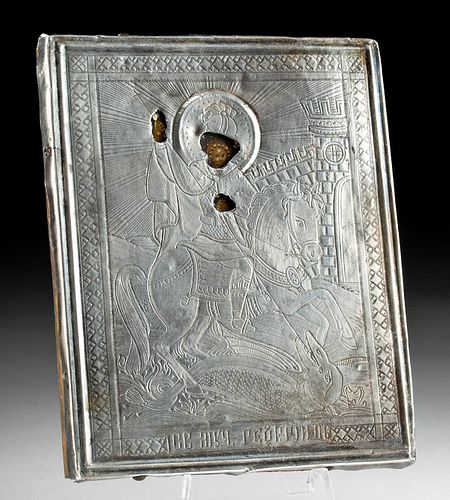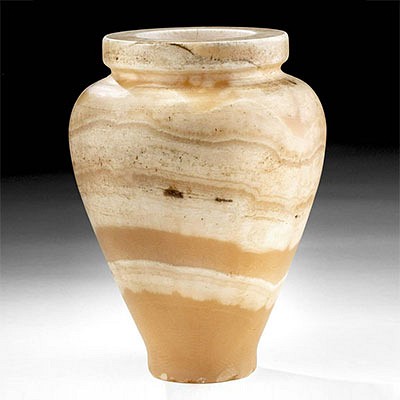19th C. Russian Icon w/ Silver Oklad - St. George
Lot 167
About Seller
Artemis Fine Arts
686 S Taylor Ave, Ste 106
Louisville, CO 80027
United States
Selling antiquities, ancient and ethnographic art online since 1993, Artemis Gallery specializes in Classical Antiquities (Egyptian, Greek, Roman, Near Eastern), Asian, Pre-Columbian, African / Tribal / Oceanographic art. Our extensive inventory includes pottery, stone, metal, wood, glass and textil...Read more
Estimate:
$600 - $900
Absentee vs Live bid
Two ways to bid:
- Leave a max absentee bid and the platform will bid on your behalf up to your maximum bid during the live auction.
- Bid live during the auction and your bids will be submitted real-time to the auctioneer.
Bid Increments
| Price | Bid Increment |
|---|---|
| $0 | $25 |
| $300 | $50 |
| $1,000 | $100 |
| $2,000 | $250 |
| $5,000 | $500 |
| $10,000 | $1,000 |
| $20,000 | $2,500 |
| $50,000 | $5,000 |
| $100,000 | $10,000 |
| $200,000 | $20,000 |
About Auction
By Artemis Fine Arts
Dec 17, 2020
Set Reminder
2020-12-17 10:00:00
2020-12-17 10:00:00
America/New_York
Bidsquare
Bidsquare : VARIETY SALE | Antiquities & Ethnographic Art
https://www.bidsquare.com/auctions/artemis-gallery/variety-sale-antiquities-ethnographic-art-6207
Featuring classical antiquities, ancient and ethnographic art from cultures encompassing the globe. Egyptian, Greek, Roman, Etruscan, Near Eastern, Asian, Pre-Columbian, Native American, African / Tribal, Oceanic, Spanish Colonial, Russian, Fossils, Fine Art, more! Artemis Fine Arts info@artemisfinearts.com
Featuring classical antiquities, ancient and ethnographic art from cultures encompassing the globe. Egyptian, Greek, Roman, Etruscan, Near Eastern, Asian, Pre-Columbian, Native American, African / Tribal, Oceanic, Spanish Colonial, Russian, Fossils, Fine Art, more! Artemis Fine Arts info@artemisfinearts.com
- Lot Description
Eastern Europe, Russia, ca. 19th century CE. A traveling icon with a hallmarked silver oklad (also oclad or riza) depicting George of Lydda - an idyllic image of victory with Saint George riding his noble steed and slaying the dragon to free the city and save the king's daughter. He is regally dressed to symbolize the triumph of good over evil, and the scene includes the monarchy's castle in the background. Framing this iconography is a border adorned with stylized geometric motifs and an inscription in Old Cyrillic at the bottom. A special example of sacred art from the Eastern Orthodox tradition. Silver quality: 99%. Size: 3.5" L x 2.875" W (8.9 cm x 7.3 cm)
Saint George was born in Lydda, Palestine during the 3rd century. He became an officer in the Roman army for Emperor Diocletian, demonstrating impressive skill in battle and receiving high honors for his courage. However, when he learned that Diocletian was preparing to persecute Christians, George presented himself publicly before the emperor and denounced him. The legend of Saint George and the Dragon, which originated in the 12th century, has immortalized the saint. However, this anecdote is rarely presented in iconography. According to tradition, St. George came to Silene in the province of Libya, where a ravaging dragon demanded daily sacrifice. Fate chose the king’s daughter, Elisaba, but George subdued the beast. He told the princess to fasten her sash about the dragon’s neck, so it could be led through the town for conversion of the people before it was killed.
The oklad or riza, sometimes referred to as a revetment in English, is a cover made from metals such as brass or silver, like this example, that not only protects the icon, but also serves to honor or venerate the figure(s) depicted on the icon. Oklads are usually adorned with repousse and/or chased work and pierced to reveal elements of the underlying painting.
Icons (icon means "image" in Greek) are sacred objects within the Eastern Orthodox Christian tradition. Found in homes as well as churches, these painted images depict holy persons and saints as well as illustrate scenes from the Scriptures. Icons are not worshiped, but are instead venerated for their ability to focus the power of an individual's prayer to God. As a focus for prayers and meditation for believers, icons serve as "windows into heaven."
Lucite stand for photographic purposes only.
Provenance: ex Estate of Dr. W.M. Bogdanowicz, Naples, Florida USA
All items legal to buy/sell under U.S. Statute covering cultural patrimony Code 2600, CHAPTER 14, and are guaranteed to be as described or your money back.
A Certificate of Authenticity will accompany all winning bids.
We ship worldwide and handle all shipping in-house for your convenience.
#160749Hallmarks on lower end include 84, signifying sterling silver, and St. George slaying the dragon which was the symbol for Moscow. A few indentations to the icon as shown, but the form is otherwise sound and the imagery is strong.Condition
- Shipping Info
-
All shipping is handled in-house for your convenience. Your invoice from Artemis Gallery will include shipping calculation instructions. If in doubt, please inquire BEFORE bidding for estimated shipping costs for individual items.
-
- Buyer's Premium



 EUR
EUR CAD
CAD AUD
AUD GBP
GBP MXN
MXN HKD
HKD CNY
CNY MYR
MYR SEK
SEK SGD
SGD CHF
CHF THB
THB














